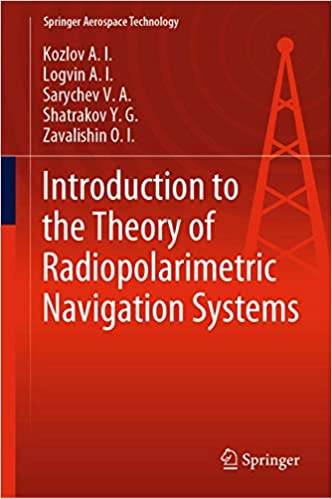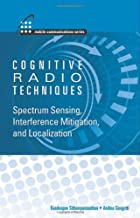Introduction to the Theory of Radiopolarimetric Navigation Systems
Original price was: ₹13,874.08.₹11,099.26Current price is: ₹11,099.26.
ISBN: 9789811383946
Author/Editor: Kozlov A L
Publisher: Springer
Year: 2020
Available on backorder
Description
The book highlights three types of technologies being developed for autonomous solution of navigation problems. These technologies are based on the polarization structure, ultra-broadband and the fluctuation characteristics (slow and fast) of the radiolocation signals. The book presents the problems of intrinsic thermal radio emission polarization and change in radio waves polarization when they are reflected from objects with non-linear properties.
The purpose of this book is to develop the foundations for creating autonomous radionavigation systems to provide aviation with navigation systems that will substantially increase its capabilities, specifically acting where satellite technologies do not work. The book is intended for specialists involved in the development and operation of aviation-technical complexes, as well as for specialists of national aviation regulators and ICAO experts dealing with the problems of improving flight safety.
Product Properties
| Year of Publication | 2020 |
|---|---|
| Table of Contents | SECTION 1. POLARIZATION STRUCTURE OF THE AUTONOMOUS RADIONAVIGATION SYSTEMS SIGNALS 1. Radiophysical provision of radiopolarimetric navigation systems. 1.1. Basic concepts and definitions of radiopolarimetry. 1.2. Interconnection and comparison of different forms of signals polarization state in radiopolarimetric navigation systems. 1.3. Polarization bases used to analyze the signals. 1.3.1. Expansion of polarized radionavigation systems signals in orthogonal polarization bases. 1.3.2. Expansion of polarized radionavigation systems signals in affine polarization bases. 1.4. Basic characteristics of probability representations of the signals polarization structure. 1.5. Quaternion representation of the signals polarization state in navigation systems. 2. Analysis of the signals polarization of radiopolarimetric navigation systems using coordinate components 2.1. Quadrature components 2.1.1. Basic properties and transformations 2.1.2. Probabilistic descriptions 2.2. Complex components 2.2.1. Basic properties and transformations 2.2.2. Probabilistic description The Gaussian case. 2.2.3. Approximation of probabilistic models. 2.2.4. Probabilistic description. The Non-Gaussian case. 2.3. Coordinate components with broadband signals. 2.4. The representation of the ultra-broadband signals polarization state of navigation systems. 3. Analysis of the signal polarization state of navigation systems based on energy characteristics. 3.1. The Coherence matrix 3.1.1. Basic properties and transformations 3.1.2. Probabilistic description 3.2. The Stokes parameters 3.2.1. Basic properties and transformations 2.2.3. Probabilistic description The Gaussian case. 3.2.3. Probabilistic description The Non-Gaussian case. 3.3. The Loss matrix 3.3.1. Basic properties and transformations 3.3.2. Influence of spectral characteristics of radio waves on their polarization properties. 4. Analysis of the signal polarization of navigation systems in the plane of geometrical parameters 4.1. Polarization phasor 4.1.1. Basic properties and transformations 4.1.2. Probabilistic description The Gaussian case. 4.1.3. Probabilistic description The Non-Gaussian case. 4.2. Polarization ellipse 4.2.1. Probabilistic description The Gaussian case. 4.2.2. Probabilistic description The Non-Gaussian case. 5. Graphic representations of the signal polarization state in navigation systems 5.1. Features of graphical representations 5.2. Representation of polarization in cylindrical and stereographic projections 5.3. Representation of radio waves polarization in cartographic projections of the Poincare sphere 5.4. Representation of polarization of thermal radio emission 5.5. Representation of polarization state on the plane. 5.6. Representation of polarization state of ultra-broadband and complex signals. SECTION 2. TRANSFORMATION OF THE POLARIZATION STRUCTURE OF THE SCATTERED AND EIGEN EMISSION OF NAVIGATION OBSERVATION OBJECTS 6. Scattering matrix and its basic properties 6.1. Scattered field and its characteristics 6.2. Stable objects of navigational observation 6.2.1. Complete scattering matrix 6.2.2. Single-position scattering matrix 6.2.3. Two - and multiple position scattering matrix 6.2.4. Scattering matrix in the affine polarization bases 6.3. Objects of navigational observation with non-linear characteristics 6.3.1. Non-linear scattering 6.3.2. Scattering matrix on non-linear reflectors 6.3.3. Effective scattering are of non-linear reflectors 6.3.4. Basic equality of non-linear radiolocation 6.4. Fluctuating objects 7. Own radio emission and scattering of radio waves 7.1. Reflection from the stable reflecting objects 7.2. Reflection from the fluctuating objects 7.2.1. The Graves matrix and the covariance matrix 7.2.2. Polarization expansion of the fluctuating object 7.2.3. Reflection of radio waves 7.3. Formation of polarized emission by inhomogeneous media 8. Scattering of polarized radio waves from surface structures and backgrounds of navigational observation 8.1. Smooth electrically homogeneous medium 8.2. Smooth electrically inhomogeneous medium 8.2.1. Common relations 8.2.2. Exponential layer 8.2.3. Quadratic layer 8.2.4. Polynomial layer 8.2.5. Linear layer 8.2.6. Parabolic layer 8.2.7. Matching layer 8.2.8. Transition layer 8.3. The equation for scattering matrix elements 8.4. Uneven surfaces 8.4.1. Electrodynamic models of uneven surfaces 8.4.2. The scattering matrix for model 1 8.4.3. The scattering matrix for model 2 8.4.4. The scattering matrix for model 3 8.4.5. The scattering matrix for model 4 8.4.6. Statistical characteristics of the scattering matrix elements of uneven surfaces 8.4.7. Statistical characteristics of electric parameters of radar targets. 8.4.8. KLL-sphere and its properties 8.4.9. Determination of electrophysical characteristics of observation objects with incomplete information on spatio-temporal state of radiolocation signals SECTION 3. RADIOPOLARIMETRY OF AUTONOMOUS NAVIGATION SYSTEMS 9. Radiolocation in radiopolarimetry navigation systems 10. Definition of structure, target and background on results from radiopolarimetric measurements. 11. Results interpretation of the radiopolarimetric monitoring systems. 12. Radiopolarimetric structures of monitoring systems. Conclusion Appendices Literature |
| Author | Kozlov A L |
| ISBN/ISSN | 9789811383946 |
| Binding | Hardback |
| Edition | 1 |
| Publisher | Springer |
You must be logged in to post a review.






Reviews
There are no reviews yet.